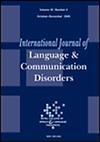An Observational Study of Discourse Tasks and Running Speech Sampling in the Assessment of Paediatric Voice Quality
Abstract
Introduction
Running speech sampling is an essential component of a paediatric voice evaluation, in that it should provide the examiner with a representative vocal sample of the child's everyday voice use outside of the clinic setting. Current speech sampling practices, consisting of reading tasks, informal conversation sampling and the voice question (‘Tell me about your voice problem’), may not elicit consistent samples or samples of sufficient length to allow the examiner to make a reliable and valid judgement about vocal quality. The aim of this study is to compare the voice quality of children produced in response to existing running speech sampling methods and narrative elicitation tasks commonly used in language sampling activities, which are hypothesized to elicit longer units of connected speech.
Methods
Fifty-three children participated in the following tasks: prolonged vowels /a/ and /i/, the CAPE-V sentences. The reference standard running speech sampling tasks were: the voice question, an informal conversation sample and the Rainbow Passage. The comparison running speech sampling tasks were: My First Day, the Bus Story Test and the Test of Narrative Language-2. All tasks were audio-recorded. The voice samples were independently rated by two trained speech-language pathologists using the CAPE-V instrument. Inter-rater reliability was acceptable for all perceptual tasks (ICC 0.901–1.00). CAPE-V ratings were considered the primary comparison measure; smoothed cepstral peak prominence was considered a secondary comparison measure. Diagnostic indicators, sensitivity, specificity and positive and negative predictive values were calculated in order to evaluate the levels of diagnostic decision-making of the comparison tasks compared to the existing reference standard tasks.
Results
On perceptual analysis, weak to strong correlations (r = 0.291–0.697) were observed between reference tasks, and weak to very strong correlations between reference and comparison tasks (r = 0.200–0.747). When diagnostic utility was compared, one or more indicators were at an acceptable level between the conversation sample and the narrative tasks, and the voice question and three out of four narrative tasks.
Conclusions
A narrative elicitation procedure, such as a re-tell or story generation task, may be suitable for eliciting a running speech sample in paediatric voice evaluations. Both the acoustic properties of the vocal signal and the perceptual properties of the voice, when compared between conversational speech and the narrative tasks, are correlated and lead to similar diagnostic decisions, as evidenced by acceptable values on the diagnostic indicators calculated in this study.
Summary
- Describe current practices in eliciting running speech samples in the evaluation of paediatric voice disorders.
- Analyze the perceptual and acoustic properties of children's voices across different genres of speech sampling at the discourse level.
- Examine the utility of formal discourse sampling as a means of eliciting running speech for paediatric voice disorders.
WHAT THIS PAPER ADDS
- Perceptual evaluation of voice quality poses challenges, particularly in the paediatric population. A running speech sample is an essential component in order to provide a representative sample of an individual's voice quality outside the clinic setting. Current sampling practices are non-standardized and may not be appropriate for all children, especially those with reading and/or language difficulties.
- This study presents data comparing the voice quality of children, elicited using current reference standard tasks and narrative sampling tasks. Such tasks are more commonly used in the evaluation of language abilities, but could illustrate a way in which a clinician could elicit a sufficiently long, ecologically valid, running speech sample for perceptual voice evaluation. In addition, the sample could be analysed as a screener of language skills.
- While this study could be considered exploratory, it is possible that using narrative elicitation techniques in paediatric voice evaluations could yield sufficiently long units of speech that are representative of a child's everyday speaking voice. Such practices would add valuable information regarding language skills to the evaluation process.


 求助内容:
求助内容: 应助结果提醒方式:
应助结果提醒方式:


